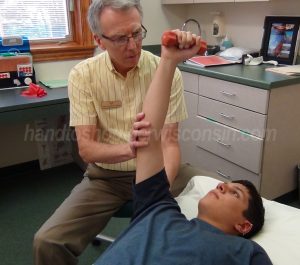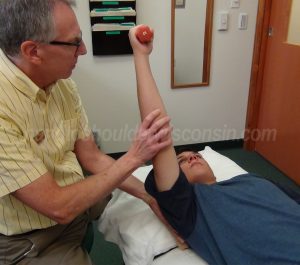Hand to Shoulder Center of Wisconsin has a team of orthopedic doctors and staff who have experience in diagnosing and treating shoulder fractures. Learn more about this injury and contact our locations in Appleton or Green Bay, WI for more information.
Shoulder Fracture
The shoulder is a complex and sophisticated joint. It’s made up of three bones: the scapula (shoulder blade), the humerus (upper arm bone), and the clavicle (collarbone); all are surrounded by a number of muscles, ligaments and tendons. Its complex structure allows for full range of motion to place the arms and hands in a variety of positions. It is the most mobile joint in the body, but it is also one of the most potentially unstable joints making it vulnerable to shoulder injuries and problems.
Shoulder trauma from a fall onto an outstretched arm is one of the common causes of shoulder pain. When people fall, they typically try to brace themselves with their hands as they are falling, allowing the energy of the fall to be transmitted up the arm to the shoulder. Other causes of fracture-related shoulder pain include sporting accidents or automobile accidents.
A fractured shoulder is often referred to as a “broken shoulder”. A fracture can be described as either displaced or non-displaced. A non-displaced shoulder fracture means that the broken pieces remain near their anatomic position. A displaced shoulder fracture often requires some type of procedure to restore the shoulder back to its normal anatomy.
Types of shoulder fractures include a proximal humerus fracture, fractured scapula, and a fractured clavicle.
Symptoms of a Fractured Shoulder
Common symptoms of a fractured shoulder include:
- Pain in the shoulder
- With a clavicle fracture, often referred to as a collar bone fracture, the clavicle pain is typically felt on the front, top portion of your shoulder. These fractures are relatively common.
- A scapula fracture involves shoulder blade pain. Scapular fractures are less common and usually involve a high-energy trauma such as an automobile or ATV accident.
- Humeral fractures involve the upper arm and are often associated with falls or dislocations.
- Swelling
- Deformity or a “bump” at the site of the fracture may be present
- Tenderness
- Bruising or discoloration down your arm from the impact of the injury
- Inability to move or raise your arm without pain
Diagnosis and Treatment for a Fractured Shoulder
The orthopedic physicians at Hand to Shoulder Center of Wisconsin perform a thorough medical evaluation. Health history is discussed along with all prior upper extremity injuries and genetic medical conditions. A physical and visual examination by the physician is completed on the shoulder; arm mobility and active and passive range of motion is measured on the affected shoulder and the opposite shoulder. X-rays are often required to help understand the severity of the fracture. A Magnetic Resonance Imaging (MRI) scan is usually not needed however, depending on the complexity of the injury, a CT scan may be ordered to further detect additional damage to the shoulder.
Shoulder pain treatment options vary depending on the severity of the fracture. In non-displaced fractures, conservative treatment is typically applied and an immobilization sling is often ordered by the physician to be worn for three to eight weeks in combination with physical or occupational therapy. The sling provides stability yet allows the weight of the arm to pull downwards helping the broken bones to heal in the correct position. It also provides flexibility to the elbow, wrist, and fingers which is essential. It is worn outside your clothes and can be easily removed for hygiene purposes. Scheduled x-rays will assure that the shoulder is healing in the proper position.
In more severe cases when the shoulder is displaced and a sling will not satisfy the condition, shoulder surgery may be necessary to stabilize and bring the fractured pieces together with wires, pins, plates, or screws. In traumatic cases when the ball portion of the upper arm is broken, crushed, or split, shoulder replacement (referred to as a hemiarthroplasty) may be needed.
All surgeons from Hand to Shoulder Center of Wisconsin, have surgical privileges at Woodland Surgery Center and all three Fox Valley hospitals.
Rehabilitation
Rehabilitation is a vital part of shoulder surgery recovery. Once your fracture begins to heal and the pain minimizes, your orthopedic surgeon will order physical or occupational therapy. The rehabilitation program will focus on pain relief, restoring range of motion, and overall function. A physical or occupational therapist will work with you on a hands-on treatment plan (Fig. 1-3) to maximize your recovery time and improve your overall outcome. Rehabilitation can typically take 6-8 weeks or more.
 Figure 1: Strengthening exercises help retrain and control the shoulder |
 Figure 2: Strengthening exercises help retrain and control the shoulder |
 Figure 3: Strengthening exercises help retrain and control the shoulder |